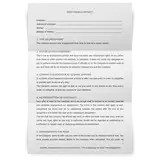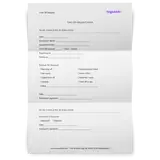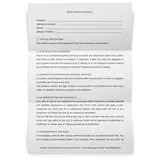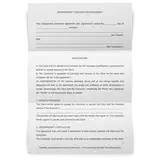An effective sow template has clear language, is detailed, and with specific timeframes and tasks. A strong sow document will ensure everyone is on the same page about what needs to get done and leaves no room for miscommunication.
An effective scope of work template will ensure you and your client have a clear idea of what a successful project looks like and details each step that you will take to get to the end result. It can help project managers and team leads to reach their project goals, avoid scope creep and make sure everyone is on the same page.
What is a Scope of Work (SoW)?
A scope of work is a detailed agreement and plan of the services or deliverables that you are going to provide to a client. The scope of work, or sometimes called a statement of work, is a document that describes the work to be performed in detail. A statement of work form is signed by the client and the outside contractor.
It clearly states timelines, any project milestones, payment terms, the number of revisions included, and deadlines that certain deliverables and services will be completed. It also defines what you will not be completing the project. It is one of the most important onboarding documents as it outlines project specifics.
A solid statement of work form prevents work outside of your original scope so the project stays within its original budget and timeframe, in the original project scope.
A well-defined statement of work template will eliminate ambiguities so both you and your client are on the same page. This article will describe how to write an effective SOW template doc, the important elements to include, and the importance of using a sow template Word document with every project to be completed.
What should be included in scope of work?
The scope of work template will clearly define all the work involved and the deliverables to be completed. It should be an easy-to-read professional document with deadlines and task times explicitly stated for all the project objectives.
Ensure that the document is accurate and that the writing is specific and thorough, to prevent project scope creep. In this guide, we’ll provide you with a free statement of work template that you can customize to your niche and field for any project, with a complete breakdown structure of what to include and leave out.
Project introduction
Before you get into the project specifics, it’s important to start from the broadest information and then work your way down to the more specific details of the project scope.
After naming the project, the next section of the statement of work template is the background explanation of the project. This section briefly describes the type of work that the project entails and identifies both parties, the client and the outside contractor.
Project overview
After the basics are covered, you’ll want to describe the primary goal of the project and address the end-results that the client and contractor are hoping to achieve. This also covers the project timeline that the project team should follow, as well as the project requirements on the client side.
Description of services or goods
The next section is called the description of services and describes the services to be completed. You’ll want to specify whether you are performing a service or completing something tangible. For complex projects, this section can take quite a bit of time with all the project details.
Task list
In this section, you’ll want to break down the large scope of your project into smaller actionable steps. This section is important because it also gives out a timeframe for each particular step. Make sure these deadlines are realistic for you to reach.
Tasks are not to be mistaken for deliverables in a project timeline, or quantifiable goods or services that will be completed at the end of a project. Tasks are specific actions that are completed in order to get to the end result of the project to complete the deliverables.
Deliverables
This section lists all project deliverables and a description of each. The project deliverables section of your statement of work template doc is where you list what exactly your client will receive at the end of the project.
Deliverables of project plans should fit into a project schedule, so keep that in mind when assigning a project team for each task.
Out of scope
This is another important section because you will want to specify deliverables or tasks that will not be completed or provided at the end of the project. You’ll want to spell out what this project will not accomplish and what goals will not be met.
This section is a great way to clear up miscommunication down the road. It also prevents additional tasks being added or the project being expanded, without additional time or budget being accounted for and keeps the project on track.
Experienced project owners know which project task is realistic and what kind of acceptance criteria to set for each project phase.
Payment terms & invoicing
For the Payment Terms and Invoicing Section, you’ll want to get as specific as possible and include estimated costs, delivery timeframes, and payment terms, as well as a payment schedule. How and when will payments be made?
Will invoices be paid at the end of each task timeframe or deliverable, on a set schedule for key milestones, or within a certain monthly or weekly timeframe? You’ll also want to address topics such as what will happen if deadlines get missed or if the scope of the work increases.
Period of performance
This section estimates and describes how long the project is going to take and describes the important milestones of the project. Specify if the basic project has a specific end date and estimate the completion of the project within a set timeframe. If you're doing the work outside of your office, you might mention the project location here too.
Your task management or project management software can give a helping hand with detailed scopes for all key stakeholders.
Expected outcomes
This section addresses the project outcomes you want to achieve for the client. For example, will the expected outcome be an increase in website traffic or a certain percentage in increase of sales? What is the business objective of this project and how will it be measured and reported?
Project management
Finally, this last section of the sow template download is where you can detail any missing information that is discussed between you and the client and get your agreements in writing.
This is a catch-all section that goes over what the other sections might not cover, such as who will be signing off for deliverables, approving changes, confidentiality, and other requirements that need to be agreed upon.
Define the terms you’re using in the scope of work template doc and any conditions or requirements that aren’t already made clear. Define the potential risks to ensure an effective project management process and that both sides are happy with the work done.
Mastering Project Management: The Role of Project Managers in Defining Scope of Work
Project management is a multifaceted discipline that requires meticulous planning and organization. At the heart of this process is the project manager, who is responsible for defining and managing the scope of work. Here's how project managers can effectively outline and control a project's scope to ensure success.
Defining the Scope of Work
- Scope of Work: The scope of work (SOW) is a detailed document that outlines all the tasks, deliverables, and timelines associated with a project. It sets clear project expectations for all stakeholders.
- Project's Scope: Defining the project's scope involves identifying the specific goals, deliverables, and boundaries of the project. This helps in preventing misunderstandings and scope creep.
Tools and Templates
- Work Breakdown Structure: A work breakdown structure (WBS) is a visual representation that breaks down the project into smaller, manageable sections. This helps in organizing tasks and tracking progress.
- Scope of Work Template: Utilizing a scope of work template can simplify the process of creating a comprehensive SOW. Templates ensure consistency and completeness.
- Work Templates: Various work templates can aid in different stages of project planning and execution, providing a structured approach to documentation.
Role of the Project Manager
- Project Manager: The project manager is the central figure in project management, responsible for planning, executing, and closing projects. They ensure that the project stays within its defined scope and meets its objectives.
- Project Owner: The project owner collaborates with the project manager to define the scope and expectations. Their involvement is crucial for aligning the project's goals with business needs.
Project Planning and Execution
- Project Planning: Effective project planning involves setting clear objectives, defining the scope, and developing a detailed project plan. This includes scheduling, resource allocation, and risk management.
- Work Document: Maintaining a comprehensive work document that includes all project details, scope, and progress is essential for transparency and accountability.
Managing Scope Creep
- Manage Scope Creep: Scope creep refers to the uncontrolled expansion of a project's scope without corresponding adjustments in time, cost, and resources. Project managers must actively manage and control scope changes to ensure project success.
- Free Scope: Offering a free scope review session can help in identifying potential areas of scope creep and addressing them early in the project lifecycle.
In project management, defining and managing the scope of work is critical to the success of any project. Project managers play a pivotal role in ensuring that all aspects of the project are clearly defined and adhered to. By using tools like the work breakdown structure and scope of work templates, and maintaining detailed work documents, project managers can effectively plan, execute, and close projects while keeping scope creep in check. This structured approach helps in meeting project expectations and delivering successful outcomes.
![Scope of Work (SoW) - Free Template (Word) [Download]](/static/image?src=https%3A%2F%2Fcdnblog.unrubble.com%2Fpayload-unrubble-images%2FScope-of-Work-Template-1-600x600.png&width=512&height=512&fit=contain&position=center&quality=65&compressionLevel=9&loop=0&delay=100&crop=null&contentType=image%2Fwebp)




